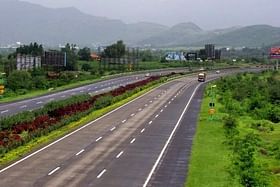Currently, it takes approximately 12 hours to travel between Pune and Bengaluru, but with this new highway, the travel time is expected to be reduced to just seven hours.
NHAI officials estimate that approximately 25,000 trees will need to be cut down for the construction, with 60 per cent of them located in Karnataka.
The Maharashtra and Karnataka state governments are currently waiting for the Centre’s approval of a detailed project report (DPR) in order to initiate the land acquisition process for the proposed greenfield Pune-Bengaluru highway project.
Estimated to be developed at a cost of Rs 50,000 crore under the Phase-2 of the Prime Minister’s flagship Bharatmala scheme.
The proposed expressway will originate at Kanjale on the under-construction ring road in Pune and terminate at Muthugadahalli in Doddaballapur taluk of Karnataka connecting to Bengaluru via the Satellite Ring Road.
At Pune, the expressway will also connect to the Pune-Mumbai Expressway.
The aim of the roughly 700-km-long Pune-Bengaluru expressway is to significantly reduce travel time between the two IT cities.
Currently, it takes approximately 12 hours to travel between Pune and Bengaluru, but with this new highway, the travel time is expected to be reduced to just seven hours.
The six-lane highway will also shorten the distance between the two cities by nearly 100 km.
The final clearance from the Centre regarding the funds and DPR is still pending.
The Maharashtra State Road Development Corporation (MSRDC) is collaborating with the National Highways Authority of India (NHAI) to expedite the land acquisition process for the Pune-Bengaluru highway.
NHAI officials have confirmed that they are in contact with the Centre regarding the clearance for the project. A senior NHAI official from Mumbai stated that the clearance is expected to be obtained in September, according to an Economic Times report.
The expressway will traverse through nine districts in Karnataka, resulting in the loss of 12,355 acre of land, as well as three districts in Maharashtra, which will lose 7,166 acre.
Although the environment impact assessment of the project is still pending, NHAI officials estimate that approximately 25,000 trees will need to be cut down for the construction, with 60 per cent of them located in Karnataka.
The proposed highway in both states will not pass through any protected area or sanctuary, but it will be located 12 km away from the Koyna wildlife sanctuary in Maharashtra.
There are a total of 444 water bodies in Karnataka that will be affected by the highway, including 19 rivers and 53 canals. In Maharashtra, there are 126 water bodies that will be impacted, including nine rivers and 36 canals.
To minimise the damage caused by the highway construction, the authorities have planned to build numerous structures.
Alignment Of Proposed Expressway
Out of the total 700 km, 206 km will pass through Maharashtra, while the remaining portion will be in Karnataka.
The alignment of the proposed expressway will be via a total of three districts in Maharashtra and nine districts in Karnataka — Pune, Satara, Sangli in Maharashtra and Belagavi, Bagalkot, Gadag, Koppal, Vijayanagara, Davanagere, Chitradurga, Tumakuru, Bengaluru Rural in Karnataka.
In Karnataka, the expressway will start from Bommanal on the Maharashtra border in Athani Taluk.
It will pass through Athani (Belagavi district) Jamakhandi, Bagalkot, Mudhol, Badami (Bagalkot district) Nargund, Ron (Gadag district), Yelaburga, Koppal Koppal district), Hagaribommanahalli, Kudligi (Vijayanagara district) Jagaluru (Davangere), Chitradurga taluk, Sira, Madhugiri, Koratagere and Tumakuru (Tumakuru district), Nelamangala and Doddaballapur (Bengaluru Rural district).
The expressway will have an interchange with other road networks at 22 places. Two emergency airstrips close to Pune and Bengaluru with a five km length will be built.
Fifty-five flyovers, a tree plantation on both sides of the expressway, and a 15-metre median for prospective widening in the future are also envisaged as part of the expressway design.
The expressway will pass through several proposed or existing industrial clusters in Karnataka.
Road experts believe that the new highway will greatly improve the road connectivity between Pune and Bengaluru, as the existing Pune-Bengaluru highway (NH-4) is already heavily congested.


